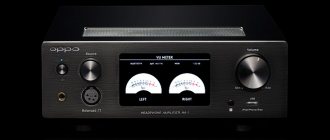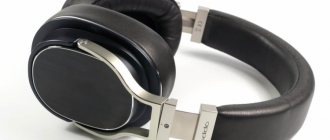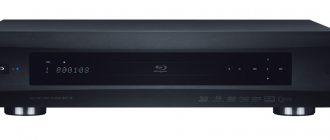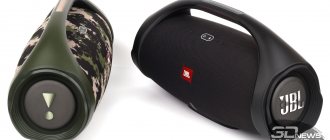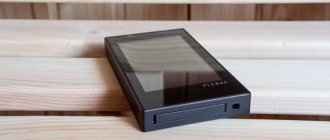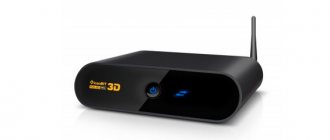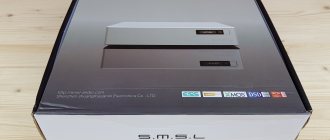To build the ideal home audio system, you need to spend a long time selecting a digital-to-analog converter (DAC), amplifier, player... Or opt for the flagship network player OPPO Sonica DAC.
The new OPPO product is ready to once again push its competitors in the premium segment, as was the case with their portable DAC for the iPhone.
If usually a player or DAC is just the beginning of a system, then Sonica DAC is a ready-made universal solution for the home, in which the developers have collected everything necessary for the most demanding customers. And instead of a remote control - an iPhone !
We tested the new product in detail and are ready to tell you what the world’s largest smartphone manufacturer offers for audiophiles, and whether the Sonica DAC is suitable for ordinary music lovers as a single device for a home audio system.
Stylish, familiar, versatile
Sonica DAC strictly follows the style of OPPO's world-conquering universal Blu-Ray players. It is strict, concise and convenient.
The rather weighty shielded black body rests on contrasting chrome legs - the perfect combination.
The front panel has a monochrome OLED display. If you're not using an app on your smartphone, this screen will be your main source of information.
In this case, control is carried out by two rotary knobs. One is necessary when working in the menu, to select the appropriate item, and for similar operations. The second is volume.
Is the new Saber chip the best you can find?
However, it is not the style that determines the sound. The main feature of the new OPPO product is the new high-end digital-to-analog converter ESS Sabre32 ES9038Pro , the company's current flagship.
So far, no one except OPPO has presented products based on it. And this despite the absolutely prohibitive characteristics of the chip! Judge for yourself:
- number of channels: 8,
- dynamic range: 140 dB,
- harmonic distortion level (THD+N): -122 dB (0.00008%),
- multi-channel decoding,
- possibility of combining DAC channels,
- decoding PCM (32 bit/768 kHz), DSD512 (22.5792 MHz).
Record dynamic range and low distortion are achieved only when all channels of the microcircuit work to reproduce one channel of the audio stream.
In other usage scenarios, the results are a little more modest, but still stand out from the general background with the highest data.
On the issue of codecs
The Sonica DAC exhibits its greatest, truly record-breaking omnivorousness in USB DAC mode. In this case, it can digest PCM streams up to 32 bit/768 kHz - I wonder if such exist in reality? DSD512, which are also supported, clearly exist, although the meaning of their presence in the world is a topic for another article. PCM signals up to 24 bit/192 kHz and DSD64 in DoP mode are received via S/PDIF.
The display is not particularly bright, but is very readable
But the MQA format, the new brainchild of Meridian founder and one of the ideologists of digital audio, Bob Stewart, is not supported under any circumstances. And I really want to believe that the point here is not so much a desire to save on licensing fees, but rather a fundamental reluctance to support an undertaking, the meaning of which, in my personal conviction, is not so much concern for guaranteed sound quality or reducing Internet traffic, but rather building a commercial a mechanism for extorting money at all stages of music creation and distribution. Those who are interested can read the criticism of MQA in more detail here, and the praises here.
Technical features of OPPO Sonica DAC
When you turn on the new product, there is no doubt about the effectiveness of the newest chip.
In addition, the Sonica DAC is equipped with the latest clock generator, allowing you to synchronize the digital signal in-house.
The device's circuit is completely balanced, and the power supply is built on a massive audiophile-grade toroidal transformer.
Omnivorous generalist
The hardware capabilities of the Sonica DAC allow the device to “swallow” almost any audio file from any source, be it a flash drive, an external hard drive, an audiophile CD player or a smartphone from the nearest phone store. Although the capabilities of the OPPO player vary depending on the source.
If the audio source is network attached storage (NAS) or sources connected via optical/coaxial connector, the maximum possible file quality is PCM (FLAC, WAV and ALAC) is 24 bit/192 kHz , DSD is 2.8 MHz (DSD64).
To play more “weighty” DSD, preliminary conversion to PCM is necessary, and on the source side. If you need to directly work with files of the highest resolution, Sonica DAC can only be used as a USB DAC (direct connection to a USB audio source).
But in this case, you can still use the simplest devices - a flash drive is enough. Or two - Sonica works perfectly with two sources at once in the digital ports, on the front and rear panels.
There are no software restrictions: when creating an audio system, you can use any combination of connection methods, using all available interfaces - and activate the required source at the right time.
Digital-to-analog decoding isn't the Sonica DAC's only superpower. It is also a full-featured network player that can play files and streams over a network ( AirPlay and DLNA ) Wi-Fi or Ethernet, via USB or a direct connection via Bluetooth.
Wireless modules can affect the sound quality, creating additional interference. However, OPPO engineers managed to minimize distortion. In addition to separate power supply, correct placement of components and high-quality wiring, one more move is used.
Radically black
So, what we have before us is radically black (there is no silver finish option), and I just want to say “brick.” With clear edges and concise (especially considering the list of features) controls. Actually, we have at our disposal a power button and two drums - a selector for inputs and operating modes, plus an electronic volume control.
The information display is quite large and easy to read. Still, monochrome OLED matrices are powerful. And the interference from them is much less (if any) than from the vacuum-electroluminescent indicators still loved by some brands. There is a USB socket under the display - you can’t live without it.
Having turned the black parallelepiped 180 degrees, the first thing we find is a set of balanced and unbalanced linear outputs. There is also a linear input, but only unbalanced. This is not without reason, but details will come later. Digital switching is represented by a standard set of inputs “optics - coaxial - USB-B”, in addition, there is another standard USB port for connecting media and gigabit Ethernet.
The back panel is packed tightly, but the connectors are located wisely and the wires do not interfere with each other
The auxiliary connectors include a trigger input and output and a ground nut - it can be useful, for example, when connecting a turntable's phono preamplifier via the linear input.
Coordination and balance are the key to quality sound
The fact is that all Sonica DAC analog outputs are balanced . Regular RCA “tulips” are also provided. Moreover, sound is supplied to them after conversion from balanced, since this type of output is redundant.
The line output level can be either fixed or adjustable, depending on need. Switching is done directly in the Sonica DAC menu.
Unfortunately, OPPO engineers did not include a headphone output in the Sonica DAC. At all. None.
Probably, in the near future we should expect the expansion of the OPPO model range with a new device, which can also be used to connect headphones to the Sonica DAC. As an option, the HA-2SE we have already reviewed is suitable.
Passport details
USB input formats: PCM up to 32 Bit/768 kHz; DSD64-256 (DoP 1.1 or native), DSD512 (native only)
Input formats S/PDIF: PCM up to 24 Bit/192 kHz; DSD64 (DoP 1.1 or native)
Line input impedance: 10 kOhm
Reproducible frequencies (DAC): 20 Hz – 160 kHz (+0/-2.4 dB); 20 Hz – 20 kHz (+0/-0.04 dB)
Max. output amplitude Signal : 4.0/2.0 V (RMS) (balanced/unbalanced output)
THD 120 dB (20 Hz – 20 kHz, A-weighted)
Channel separation: >120 dB
Dynamic Range: >120 dB (1 kHz, –60 dB, A-weighted)
Wireless connections: Wi-Fi 802.11 a/b/g/n/ac; Bluetooth 4.1
Hello, dear lovers of high-quality sound. OPPO does not stop experimenting, releasing very interesting and functional products to the Hi-Fi audio and video market. The hero of our today's review is the oppo sonica dac network player. In fact, its functions are not limited to the ability to play network audio content alone. This is a universal device that can simultaneously act as an ADC, balanced preamplifier, network streamer and player. What is important is that each of the functions is perfectly implemented.
Why iPhone is the best remote control
OPPO does not come with a remote control. And not at all because the manufacturer gives the buyer the opportunity to choose any suitable infrared manipulator for home appliances.
Sonica DAC is controlled using a smartphone on iOS or Android via a proprietary application via Wi-Fi.
Using Wi-Fi instead of Bluetooth ensures reliable communication with the device anywhere in the room, as long as the router is within reach. Ideal for large areas and private homes.
The functionality is the same for different platforms; all management is carried out in it, except for the initial settings. Interestingly, there is no desktop client provided. But the good news is that when you connect a smartphone via Wi-Fi as a remote control, you can connect another via Bluetooth as a sound source.
The app is as intuitive as it gets. It contains a hidden system for setting up the DAC itself, wireless and wired acoustics. You can set the delay, correct the stage, and refine the subtle aspects of the sound. Multi-zone systems are built here.
True, multiroom can only be built using Sonica branded wireless speakers - they work via Wi-Fi or LAN. Connection is literally two clicks on the screen.
Thanks to native support for DLNA and Airplay, any home server, router with a hard drive or computer easily turns into a recording source. Switching between interfaces and inputs is done directly in the application.
The built-in monochrome screen contains only text information in the form of data about the track being played (indicating the format and resolution).
In fact, the smartphone screen replaces the Sonica DAC's own. Covers are displayed here, playlists are selected, sources and the composition itself are selected. Important - there are no restrictions on the directory structure or the length of the file path.
Not just multiroom
The word “Sonica” in the name transparently hints at the device’s belonging to the multi-room ecosystem of the same name, which currently also includes a pair of active wireless speakers of different classes and different powers. We talked in detail about the younger model here.
With the advent of Sonica DAC, fans of wireless installations have the opportunity to integrate any analog source into them - even a turntable or cassette deck. It is enough to connect such a device to the line input, and music from it, of course after digitization in real time, can be listened to from Sonica speaker systems throughout the house.
The Source drum not only rotates, but is also pressed to confirm the selected setting
It is worth noting here that the signal supplied to this input is digitalized in any case, and therefore it will not be possible to use our unit as a simple switch. Pass-through from input to output is possible, but only at the cost of double analog-to-digital and digital-to-analog conversion. Apparently that’s why there are no XLR input connectors - what’s the point of them if the content will be converted into a stream with a sampling frequency of a maximum of 48 kHz for subsequent sending to compact wireless speakers?
By the way, one more subtle point: if the DAC is configured for an active connection in a multiroom system, then all tracks, regardless of their source and initial characteristics, will be played back with a downsampling frequency to 44.1 kHz or 48 kHz, so be careful.
How Tidal is replacing your traditional music collection
The application developers did not equip it with support for Internet radio and streaming services - except for Tidal. From inside you can play only audio recordings downloaded to a flash drive.
However, a paid Tidal account, which is required for use with the official application, completely replaces any other audio sources. Moreover, today this is actually the only streaming resource with lossless recordings available in Russia. Pay and listen to your pleasure.
The selection of available hi-res albums is comparable to those presented on trackers, and, unlike pirated resources, they have stable quality without upscaling
During testing, the service's music reserves were studied in detail. Of course, rare recordings of Novosibirsk punks or St. Petersburg shoegaze bands cannot be found there yet - just like on other streaming resources.
The selection is slightly smaller than in Google Music or iTunes , but all new releases, popular hits and simply well-known bands are presented in full. And pop, and rock, and metal.
It is accessed from the menu. And right in the application you can create your own playlists, selections of your favorite tracks - just like in any good software player. The quality of the stream is regulated here: check the Hi-Fi box - you listen losseless, the network does not pull - reduced the bitrate.
Play all
On the other hand, the appearance of a serious source with truly high-quality preamplification automatically moves the Sonica family from the class of solutions for high-quality background sound of living spaces to the rank of truly high-class musical ecosystems. After all, from the same application installed on an Android or iOS gadget, you can now send music to both a compact speaker by the bed and a stereo system with a tube amplifier and floor-standing speakers.
From smartphones, music can be sent to the DAC via Bluetooth, Wi-Fi or a direct USB connection
Where to send from is a separate topic. Sonica DAC can play music files from external network storage that supports DLNA, from USB drives, accepts streaming via AirPlay or Bluetooth, as well as digital streams generated by Sonica devices and applications on a Wi-Fi network. True, of the online music services, only Tidal is currently supported; Internet radio reception is not even available. There is only one way to get around this problem - connect your mobile gadget via Bluetooth and launch the corresponding application from another developer. The method is not the most convenient, especially considering that the device does not seem to support the aptX codec. At least I couldn't activate it.
System sound test: OPPO and Dynaudio
Most audiophile systems require close attention from the user at every step: choose, listen, buy; deliver carefully, install and connect correctly; listen, be disappointed, redo it. Repeat until you get the desired effect, fatigue, or purchase a new system.
The capabilities of Sonica DAC allow you to simplify the process to the limit, using arbitrary components. In our case they turned out to be:
- player/DAC - Sonica DAC ;
- amplifier/acoustics - active speaker Dynaudio Excite X14A ;
- source: Synology ;
- remote control - iPhone 7
- wires - unnamed
The Excite X14A turned out to be the most suitable acoustics, as it uses a matched connection via XLR and a bi-amp circuit for its 2 amplifiers (50 W for the tweeter, 50 W for the bass and midrange).
Assembling the audio system turned out to be as easy as shelling pears: we installed it on the table, connected the wires, and threw a dozen albums into the NAS. Using DLNA with an infrared remote would be a nightmare, even with an external screen. From a smartphone - turn it on, press it, it starts playing. And they began two weeks of daily testing.
Sonica DAC has shown its absolute user friendliness.
As already mentioned, DSD512 is only possible if the audio source is directly connected to the Sonica DAC via a USB DAC. Therefore, the listening was carried out in three passes - from Tidal, from the iPhone and with a wired connection. And, of course, looking ahead, Tidal is unrivaled because it combines convenience and quality.
*****
In each case, the system showed amazing sound purity, incredible balance of all components and crazy accuracy. Even in those compositions from which you no longer expect anything new - for example, the usual melodies of the 2000s: The Offspring, Robbie Williams, RHCP and the like mainstream.
What can I say - the classic Flatwood Mac sparkled with new colors (I can’t stand it - but it was interesting to listen to on the Sonica DAC)! It is worth noting that the effect works on simple recordings, even with mp3 files transmitted via Bluetooth.
The Sonica DAC is perhaps the only case I know of where ultra-high resolution audio files actually bring benefits. The lion's share of competitors in a similar scenario turn a live composition into a boring studio project for mixing.
Instead of dry analyticalness, OPPO's development amazes with lively, rich, vibrant sound.
The instruments are clearly distinguishable, and any part can be highlighted if desired: the guitars do not overwhelm even the double bass, and the saxophone does not interrupt the vocals. Even in a composition where mixing is expected: it can definitely be recommended for fans of psychobilly. The Meteors and Mad Sin (for those who are not in the know - bootleg vs. modern studio recording) sound equally intelligible.
When listening, an accurate acoustic scene is built. Each instrument or voice has its own position in three-dimensional space, without being masked by its neighbors. Even in complex compositions with an orchestra, this is why the symphonic subtypes of metal ( Epica , Therion and Haggard ) instantly immerse you in their fantasy-medieval worlds.
Perhaps the biggest surprise is associated with this category: now the office listens to Dimmu Borgir and enjoys an indescribable variety of sound. True, through the wire, my own rip from vinyl.
Direct connection of the source and improvement of the quality of audio files allows you to improve the high frequencies of compositions to the limit of human hearing, revealing the smallest details that are not heard in ordinary material. So the sound becomes drier and less interesting - which can play into the hands of certain categories of listeners.
However, excessive quality can always be made worse by simply changing the speakers, their location in space or using wireless connection interfaces.
Hearing something new in your favorite compositions is priceless.
The difference everyone can hear
In fact, Sonica DAC is currently the only audio device available in the world on the flagship ESS Saber . All few competitors are significantly more expensive. Therefore, if we talk about price, OPPO again managed to surprise customers with an affordable product in the premium segment.
If we consider sound, then Sonica DAC has no competitors . To build a similar system based on another DAC, you will have to pay considerable sums. In addition, no one guarantees the “love” of disparate components for each other - which means additional expenses are quite possible.
Using the hero of the review with good active acoustics allows you to create a unique audio system in terms of quality/price ratio: incredibly clear sound, balanced characteristics of Sonica DAC and convenient controls turn a purely audiophile piece of furniture into a justified purchase that will take a central place in the multimedia system of any home or apartment .
On a personal note, I would recommend the Sonica DAC for a starter system paired with a simple active system. An excellent option for further improvements, which, however, may linger for a decade.
All that remains is to persuade my wife.
One listen is enough to get used to the quality. And it’s almost impossible to refuse.
(5.00 out of 5, rated: 2)
The OPPO brand has been popular lately, and, characteristically, this is happening not only through the efforts of advertisers, but also from hardware developers. After all, they were the ones who created the first Ultra HD Blu-ray player with Dolby Vision support, and in Russia the UDP-203 is still the only ultra-high definition disc source on the DC market. Oops, not the only one: a month ago another brainchild of OPPO appeared - UDP-205. However, today we will talk about a purely sound device, which does not have much in common with the players listed above. However, family traits will always appear somewhere, but first things first.
The hero of today's test is the Sonica DAC network audio player. At least the manufacturer himself classifies it specifically in this category of devices. It must be said that one of the greatest strengths of OPPO hardware is its amazing versatility. Take the same player UDP-205, which plays laser discs almost everything, and plays high-resolution files (both audio and video) from network media, and plays via USB at a very serious level. So, by calling the Sonica DAC simply a “network player,” the guys from OPPO were clearly being modest. In fact, we have before us a combination of a network/USB player with an external DAC, a balanced preamplifier and a network streamer, armed with wireless interfaces and ADC functions. In a word, the wealth of functionality is quite in the style of its video relatives. But before we begin to study it in detail, we will perform a traditional external examination.

